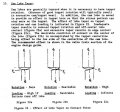I thought as you did about installing new lifters on a used cam - it is actually the WORST case scenario for failure. C'mon Grumpy, add the link and pictures.
SEE #3
(quote-SUMMIT)
Q: What causes a
camshaft to fail?
A: We’ve gotten that question (or something very similar) a lot. We’ve also heard a lot of questions about camshaft installation and break-in procedure. Since proper installation and break-in go hand-in-hand with camshaft success or failure, we’ve decided to tackle it all in one post. In conjunction with the
Summit Racing tech department, we’ve assembled the eight most common causes of camshaft failure:
1. Lobe wear
Lobe wear is often caused by improper lubrication during installation.
Use only the manufacturer recommended lubricant, which is generally included with the cam. This lubricant must be applied to every cam lobe surface, and to the bottom of every lifter face of all flat tappet cams. Roller tappet cams only require engine oil to be applied to the lifters and cam.
Also, apply the lubricant to the distributor drive gears on the cam and distributor.
2. Improper Break-In
After the correct break-in lubricant is applied to the cam and lifters, fill the crankcase with fresh, non-synthetic oil. Use motor oil with an engine break-in additive (ZDDP or ZINC camshaft additive), especially with flat tappet
camshafts.
Prime the oil system with a priming tool and an electric drill so that all oil passages and the oil filter are full. Preset the ignition timing and prime the fuel system. Fill the cooling system. Start the engine, run it between 1,500 and 3,000 rpm, varying the rpm up and down in this range for 20 minutes. During break-in, verify that the pushrods are rotating, as this will show that the lifters are also rotating. If the lifters don’t rotate, the cam lobe and lifter will fail. Sometimes you may need to help spin the pushrod to start the rotation process.
3. Old Lifters with a New Cam
You can use new
lifters on a good used cam, but never pair used lifters with a new cam.
If you are removing a good used
flat tappet cam and lifters and are planning to use them again in the same (or another) engine, you must keep the lifters in the order they were removed from the cam they were on. Lifters “mate” to their specific lobes and can’t be changed. If the used lifters get mixed up, discard them, install a new set of lifters, and break in the cam again.


